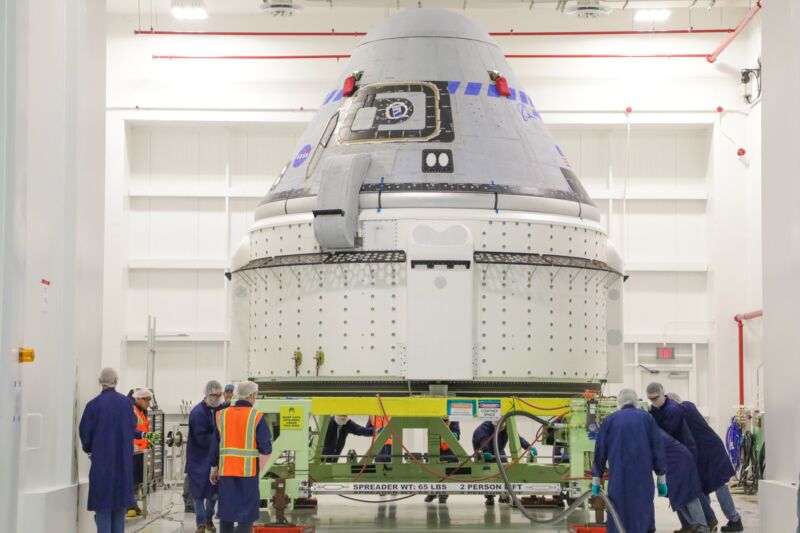Boeing and NASA say the Starliner spacecraft is ready for a do-over flight, with a second uncrewed test mission of the spacecraft now scheduled for May 19.
Nine months have passed since a standard pre-flight check of the spacecraft, then sitting atop a rocket on a launch pad in Florida, found that 13 of 24 oxidizer valves within Starliner's propulsion system were stuck. The discovery was made within hours of liftoff.
Since then, engineers and technicians at Boeing and NASA have worked to fully understand why the valves were stuck and to fix the problem. They found that the dinitrogen tetroxide oxidizer that had been loaded onto the spacecraft 46 days prior to launch had combined with ambient humidity to create nitric acid, which had started the process of corrosion inside the valve's aluminum housing.
On Tuesday, during a teleconference with reporters, officials from Boeing and NASA discussed the steps they have taken to ameliorate the problem for Starliner's upcoming test flight. Michelle Parker, vice president and deputy general manager of Boeing Space and Launch, said the valves remain the same on the vehicle but that technicians have sealed up pathways by which moisture might get inside the propulsion system. They are also purging moisture from the valves using nitrogen gas and loading propellants onto Starliner closer to launch.
With those mitigations undertaken, Starliner will soon be stacked on top of an Atlas V rocket built by United Launch Alliance. Starliner was in fact due to roll out to the Atlas V launch complex in Florida on Wednesday, but Boeing said the rollout was "paused" due to a hydraulic leak on United Launch Alliance's transport vehicle.
So it goes with Boeing's start-and-stop efforts to bring Starliner into service. The company has been working on the vehicle since at least 2010, when it was called Crew Space Transportation-100, or CST-100. Starliner made its debut flight in December 2019, but problems cropped up just minutes after liftoff, when the spacecraft captured the wrong "mission elapsed time" from its Atlas V launch vehicle. It also had difficulty communicating with ground stations. Flight controllers at NASA and Boeing were able to restore communications with Starliner and help it reach orbit. However, because of the propellant spent during these activities, Starliner was unable to complete its primary objective, demonstrating a safe docking with the International Space Station.
There were also problems during the return journey to Earth. Another software error, caught and fixed just a few hours before the vehicle returned to Earth through the atmosphere, would have caused thrusters on Starliner's service module to fire in the wrong manner. The vehicle was nearly lost a second time.
These problems led NASA to declare the first Starliner test flight a "high visibility close call" and set off a years-long investigation and deep dive into Starliner's software problems. Boeing agreed to pay for a second test flight at a cost of $410 million and eventually readied the Orbital Flight Test-2 mission that reached the pad in the summer of 2021. Then, the vehicle had its sticky valve issue. Finally, after all of that, the company has Starliner back on the pad, ready for a do-over of the do-over launch.
NASA, of course, presently has SpaceX's Crew Dragon spacecraft to get its astronauts to and from the International Space Station. Crew Dragon has flown five largely flawless crewed missions since mid-2020, but with tensions high between the United States and Russia, NASA would very much like to have a second crew transportation option to reach the station.
That means there is high interest at NASA in Starliner's second test. Success with this test flight would likely set Boeing up to fly crew to the space station for the first time early in 2023.
"This is a really important step in our continued goal of having two US transportation capabilities to the ISS," said NASA's Kathy Lueders, chief of human spaceflight operations. "Robust crew services is really important to our sustained commitment to our research, the science and technology development that we're doing on the ISS, and it is critical for us meeting our exploration goals."



3175x175(CURRENT).thumb.jpg.b05acc060982b36f5891ba728e6d953c.jpg)

Recommended Comments
There are no comments to display.
Join the conversation
You can post now and register later. If you have an account, sign in now to post with your account.
Note: Your post will require moderator approval before it will be visible.